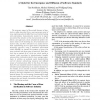Free Online Productivity Tools
i2Speak
i2Symbol
i2OCR
iTex2Img
iWeb2Print
iWeb2Shot
i2Type
iPdf2Split
iPdf2Merge
i2Bopomofo
i2Arabic
i2Style
i2Image
i2PDF
iLatex2Rtf
Sci2ools
110
Voted
HICSS
2003
IEEE
2003
IEEE
A Model for the Emergence and Diffusion of Software Standards
The economic impact of the growth dynamic of standards is often described from a macroeconomic point of view, employing network effect theory and models dealing with externalities. Game-theoretic models try to depict and predict the situation on the microeconomic side. We follow a new approach, which simulates the system’s behavior based on the modeling of a set of individual conduction rules, and their interaction in a closed environment. Implementing such an Agent based Computational Economics approach, using a simulation environment called SWARM, we assume the existence of three firm sizes combined with three types of standards. Each standard has an optimal fit to a firm size, which results in reduced costs according to standardization benefits, whereas other combinations lead to lower savings respectively. In addition we postulate initial standardization cost for internal restructuring measures and different scopes of communication fitted to the three firm types. Each firm can r...
Related Content
| Added | 04 Jul 2010 |
| Updated | 04 Jul 2010 |
| Type | Conference |
| Year | 2003 |
| Where | HICSS |
| Authors | Tim Stockheim, Michael Schwind, Wolfgang König |
Comments (0)

